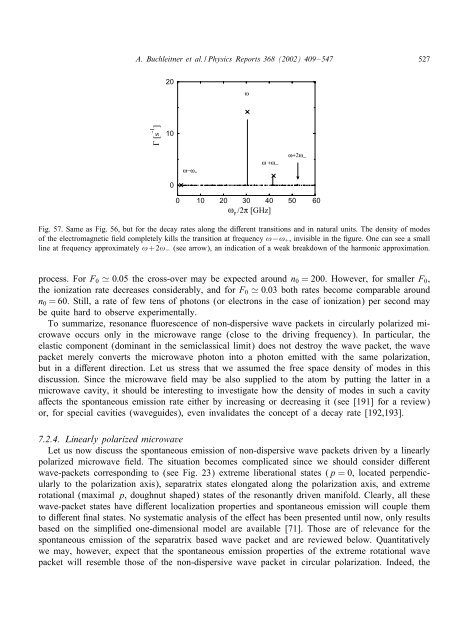Non-dispersive wave packets in periodically driven quantum systems
Non-dispersive wave packets in periodically driven quantum systems
Non-dispersive wave packets in periodically driven quantum systems
Create successful ePaper yourself
Turn your PDF publications into a flip-book with our unique Google optimized e-Paper software.
A. Buchleitner et al. / Physics Reports 368 (2002) 409–547 527<br />
Γ [s -1 ]<br />
20<br />
10<br />
0<br />
ω−ω +<br />
ω<br />
ω +ω −<br />
ω+2ω −<br />
0 10 20 30 40 50 60<br />
ωp<br />
/2π [GHz]<br />
Fig. 57. Same as Fig. 56, but for the decay rates along the di erent transitions and <strong>in</strong> natural units. The density of modes<br />
of the electromagnetic eld completely kills the transition at frequency !−!+, <strong>in</strong>visible <strong>in</strong> the gure. One can see a small<br />
l<strong>in</strong>e at frequency approximately ! +2!− (see arrow), an <strong>in</strong>dication of a weak breakdown of the harmonic approximation.<br />
process. For F0 0:05 the cross-over may be expected around n0 = 200. However, for smaller F0,<br />
the ionization rate decreases considerably, and for F0 0:03 both rates become comparable around<br />
n0 = 60. Still, a rate of few tens of photons (or electrons <strong>in</strong> the case of ionization) per second may<br />
be quite hard to observe experimentally.<br />
To summarize, resonance uorescence of non-<strong>dispersive</strong> <strong>wave</strong> <strong>packets</strong> <strong>in</strong> circularly polarized micro<strong>wave</strong><br />
occurs only <strong>in</strong> the micro<strong>wave</strong> range (close to the driv<strong>in</strong>g frequency). In particular, the<br />
elastic component (dom<strong>in</strong>ant <strong>in</strong> the semiclassical limit) does not destroy the <strong>wave</strong> packet, the <strong>wave</strong><br />
packet merely converts the micro<strong>wave</strong> photon <strong>in</strong>to a photon emitted with the same polarization,<br />
but <strong>in</strong> a di erent direction. Let us stress that we assumed the free space density of modes <strong>in</strong> this<br />
discussion. S<strong>in</strong>ce the micro<strong>wave</strong> eld may be also supplied to the atom by putt<strong>in</strong>g the latter <strong>in</strong> a<br />
micro<strong>wave</strong> cavity, it should be <strong>in</strong>terest<strong>in</strong>g to <strong>in</strong>vestigate how the density of modes <strong>in</strong> such a cavity<br />
a ects the spontaneous emission rate either by <strong>in</strong>creas<strong>in</strong>g or decreas<strong>in</strong>g it (see [191] for a review)<br />
or, for special cavities (<strong>wave</strong>guides), even <strong>in</strong>validates the concept of a decay rate [192,193].<br />
7.2.4. L<strong>in</strong>early polarized micro<strong>wave</strong><br />
Let us now discuss the spontaneous emission of non-<strong>dispersive</strong> <strong>wave</strong> <strong>packets</strong> <strong>driven</strong> by a l<strong>in</strong>early<br />
polarized micro<strong>wave</strong> eld. The situation becomes complicated s<strong>in</strong>ce we should consider di erent<br />
<strong>wave</strong>-<strong>packets</strong> correspond<strong>in</strong>g to (see Fig. 23) extreme liberational states (p = 0, located perpendicularly<br />
to the polarization axis), separatrix states elongated along the polarization axis, and extreme<br />
rotational (maximal p, doughnut shaped) states of the resonantly <strong>driven</strong> manifold. Clearly, all these<br />
<strong>wave</strong>-packet states have di erent localization properties and spontaneous emission will couple them<br />
to di erent nal states. No systematic analysis of the e ect has been presented until now, only results<br />
based on the simpli ed one-dimensional model are available [71]. Those are of relevance for the<br />
spontaneous emission of the separatrix based <strong>wave</strong> packet and are reviewed below. Quantitatively<br />
we may, however, expect that the spontaneous emission properties of the extreme rotational <strong>wave</strong><br />
packet will resemble those of the non-<strong>dispersive</strong> <strong>wave</strong> packet <strong>in</strong> circular polarization. Indeed, the











